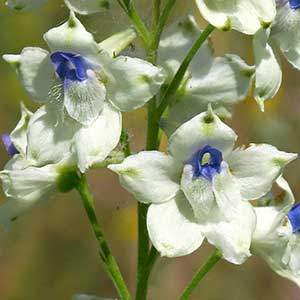Delphinium nuttallii subsp. ochroleucum
(synonym of Delphinium leucophaeum)
Delphinium gypsophilum
pale larkspur, white rock larkspur
gypsum-loving larkspur, Pinoche Creek larkspur
30-60 cm.
(30-)60-100(-150) cm;
base usually reddish, glabrous, glaucous.
blade round to pentagonal, 1.5-6 × 2-12 cm, nearly glabrous; ultimate lobes 3-12, width 3-24 mm (basal), 1-8 mm (cauline).
15-30(-64)-flowered, cylindric;
pedicel spreading, (0.5-)1.5-3.5 cm, glabrous;
bracteoles 2-6 mm from flowers, green, linear, 2-5 mm, glabrous.
sepals white or light yellow, spurs 9-11 mm;
lower petal blades 4-6 mm.
sepals rarely reflexed, white to pink, nearly glabrous, lateral sepals spreading, 7-19 × 3-10 mm, spurs straight to upcurved, ascending 30-45° above horizontal, 7-15 mm;
lower petal blades elevated, exposing stamens, 3-8 mm, clefts 1-4 mm;
hairs centered near base of cleft, ± evenly distributed, white.
9-18 mm, 2.5-3.2 times longer than wide, puberulent.
seed coat cells brick-shaped, cell margins undulate, surfaces roughened.
= 16.
Delphinium nuttallii subsp. ochroleucum
Delphinium gypsophilum
Of conservation concern.
The range of morphologic features of Delphinium nuttallii subsp. ochroleucum (D. leucophaeum) is almost completely encompassed within that of D. nuttallii subsp. nuttallii. Sepal color is the only feature consistently separating the two subspecies. Were it not for the fact that any given population typically has plants of only one flower color, a rank of forma would be more appropriate.
(Discussion copyrighted by Flora of North America; reprinted with permission.)
Subspecies 2 (2 in the flora).
Delphinium gypsophilum is sometimes confused with D. hesperium subsp. pallescens, D. recurvatum, and the white-flowered phases of D. hansenii subsp. kernense. The echinate seeds and long-haired petioles of D. hansenii immediately distinguish it from D. gypsophilum, which has neither.
Delphinium gypsophilum is related, and similar in many respects, to D. recurvatum. The two may be distinguished morphologically by their sepals. Delphinium recurvatum has reflexed, blue sepals; those of D. gypsophilum are spreading and white, although they may change to light blue when dry. Plants of D. recurvatum normally are less than 60 cm; those of D. gypsophilum are usually more than 60 cm. Ecologically, D. recurvatum occupies level ground among shrubs, typically in alkaline valley bottoms; D. gypsophilum is found on well-drained hillsides among grasses and in chaparral and oak woodland.
From Delphinium hesperium subsp. pallescens, specimens of D. gypsophilum may be separated by their much more finely dissected leaves, with less surface area, stem base usually reddish, stems frequently glaucous proximally, undulate margins of seed coat cells, and absence of striations in stem base of dried specimens. In contrast, D. hesperium subsp. pallescens has leaves less dissected, with greater surface area, stem base rarely reddish, stem not glaucous proximally, seed coat cells with straight margins, and striations present on the proximal stem of dried specimens.
(Discussion copyrighted by Flora of North America; reprinted with permission.)
1. Lower petals 5–8 mm; lateral sepals 10 mm or more; pedicel usually more than 1 cm apart. | subsp. gypsophilum |
1. Lower petals 3–5 mm; lateral sepals 10 mm or less; pedicel usually less than 1 cm apart. | subsp. parviflorum |


